DDR3 Memory
DDR2 moved the "notch" to a different location so DDR2 could not be mounted in a DDR slot by accident, and vice versa. DDR3 provides a third notch configuration, designed to prevent mounting in older DDR and DDR2 slots.
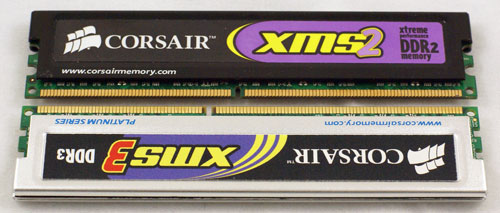
The first DDR3 memory to show up in our labs is from Wintec, who will market the DDR3 kit under their AmpX brand name.
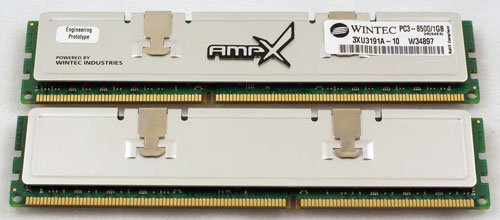
Corsair has also been at the forefront of DDR3 development and provided a Corsair 2 GB DDR3 kit for evaluation.

Both the Wintec and Corsair parts are rated at DDR3-1066 at 7-7-7-20 timings. Corsair also has a 1333 part that should be released in the next two weeks. We will follow up with that 1333 rated memory as soon as it is available.
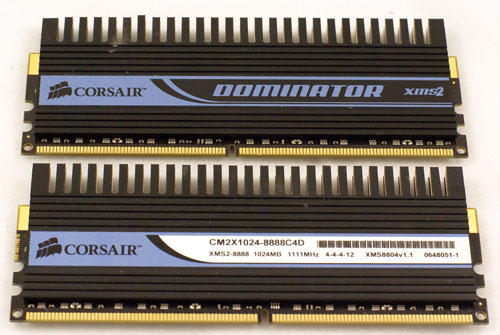
DDR2 memory was also needed for the older P965 and new P35-based ASUS P5K Deluxe. Corsair Dominator DDR2-1111 was chosen for the wide range of available DDR2 memory speeds and the excellent timings available at DDR2-800 and DDR2-1067.
P35 Motherboards
Since the primary goal was to compare DDR2 and DDR3 performance it was important to find P35 motherboards that supported DDR2 and DDR3 in as similar a configuration as possible. ASUS will be marketing a pair of premium motherboards that differ only in the memory each motherboard supports.
The ASUS P5K3 Deluxe is powered by the Intel P35 chipset and fully supports DDR3 memory to an official DDR3-1333 speed.
The ASUS P5K Deluxe is based on the same P35 chipset but supports DDR2 memory. There are other minor differences in the two boards, but they are basically the same board supporting different memory types. This is exactly the configuration needed for our comparison.
For comparison to a current Intel chipset, the ASUS P5B Deluxe was used.
This excellent motherboard received the Gold Editors' Choice in the conclusion to our recent P965 motherboard roundup. It also supports a wide range of memory voltages and speeds which make it ideal for comparison testing to the P35 motherboards.
DDR2 moved the "notch" to a different location so DDR2 could not be mounted in a DDR slot by accident, and vice versa. DDR3 provides a third notch configuration, designed to prevent mounting in older DDR and DDR2 slots.

The first DDR3 memory to show up in our labs is from Wintec, who will market the DDR3 kit under their AmpX brand name.

Corsair has also been at the forefront of DDR3 development and provided a Corsair 2 GB DDR3 kit for evaluation.

Both the Wintec and Corsair parts are rated at DDR3-1066 at 7-7-7-20 timings. Corsair also has a 1333 part that should be released in the next two weeks. We will follow up with that 1333 rated memory as soon as it is available.

DDR2 memory was also needed for the older P965 and new P35-based ASUS P5K Deluxe. Corsair Dominator DDR2-1111 was chosen for the wide range of available DDR2 memory speeds and the excellent timings available at DDR2-800 and DDR2-1067.
P35 Motherboards
Since the primary goal was to compare DDR2 and DDR3 performance it was important to find P35 motherboards that supported DDR2 and DDR3 in as similar a configuration as possible. ASUS will be marketing a pair of premium motherboards that differ only in the memory each motherboard supports.
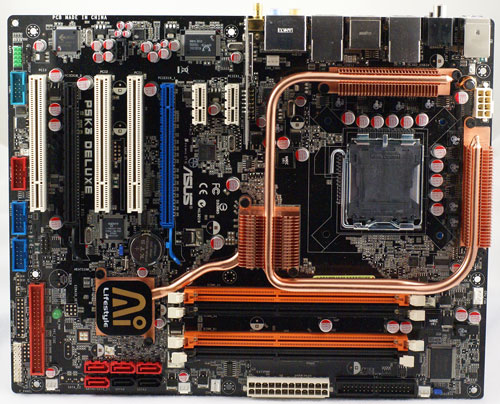 |
| Click to enlarge |
The ASUS P5K3 Deluxe is powered by the Intel P35 chipset and fully supports DDR3 memory to an official DDR3-1333 speed.
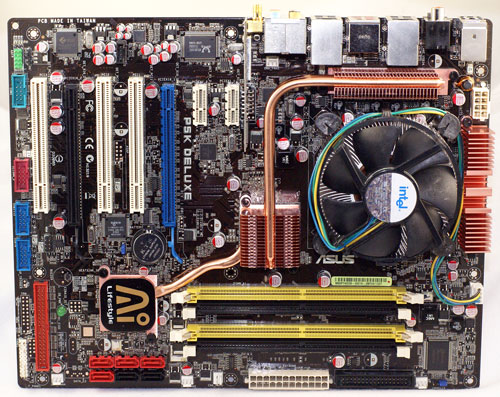 |
| Click to enlarge |
The ASUS P5K Deluxe is based on the same P35 chipset but supports DDR2 memory. There are other minor differences in the two boards, but they are basically the same board supporting different memory types. This is exactly the configuration needed for our comparison.
For comparison to a current Intel chipset, the ASUS P5B Deluxe was used.
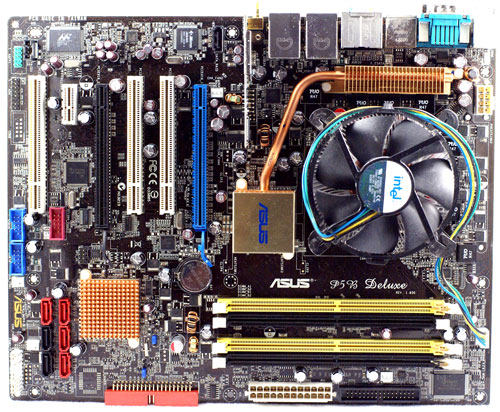 |
| Click to enlarge |
This excellent motherboard received the Gold Editors' Choice in the conclusion to our recent P965 motherboard roundup. It also supports a wide range of memory voltages and speeds which make it ideal for comparison testing to the P35 motherboards.










45 Comments
View All Comments
Final Hamlet - Tuesday, May 15, 2007 - link
Oh look! It's Bicycle repair man!just4U - Wednesday, May 16, 2007 - link
I don't really know what to think with ddr3 .. or even ddr2.When I jumped from PC 2700 memory (cas 3 i think) up to PC3200 memory cas 2 I noticed a increase in the overall speed of my computer.
When I jumped to DDR2 PC5300 I noticed no speed increase. When I jumped to PC6400 I noticed no speed increase. When I overclock my memory I notice no...
You get the picture.
I have a question. DDR3 with tight timings, Will we accualy notice it over ddr2? Or will it be one of those things where only a benchmark tends to notice anything.
Starglider - Friday, May 18, 2007 - link
Depends on what applications you're running. But based on your recent experience, probably not.defter - Tuesday, May 15, 2007 - link
The article says that P965 board was running at 1066MHz FSB and then writer is suprised when P35 + DDR2 running at 1333MHz FSB is slightly faster??? Then in the conclusion it's said that the reason for an increased performance is the chipset instead of a higher FSB???If you want to make P965 vs P35+DDR2 comparision, why not use the same FSB.....
Wesley Fink - Tuesday, May 15, 2007 - link
The P965 was running at 10x266 or 2.66GHz. The P35 boards ran at 8x333 or 2.66GHz. 1333 is not a natural CPU ratio on the P965 so when you choose 1333 there is no way to also choose DDR2-800. At 1333 the closest you can get (at a different strap) is 833. We believe the way we tested was as close to apples to apples as we could design. Remember we are looking at MEMORY PERFOMNACE, and the FSB should not matter as long as memory speed and timings are set the same on all test boards, which we definitley insured.Despite that, we know that Sandra XI results can be influenced a small amount by CPU speed and possibly FSB. To make sure our results were still as close to apples to apples as possible we did run 10x266 on all boards and compared results to our test setup. The MEMORY PERFORMANCE results were virtually the same as we have reported.
We do agree that were we testing CPU performance the differing bus speeds at the same resulatant CPU speed could make some difference.
IntelUser2000 - Wednesday, May 16, 2007 - link
Defter is right. You guys were just testing performance increase by using a 1333FSB instead of 1066FSB. Memory bandwidth tests like Sandra will show HUGE differences. Remember, the CPU will not benefit from faster memory when FSB isn't faster. It's different from AMD where Hypertransport is only used for northbridge to southbridge communications(which yields into 0% improvement ) for PC.
Wesley Fink - Wednesday, May 16, 2007 - link
P35 is a combination of an increase in bus speed to 1333 and an improved memory controller. We are working on a followup article to appear in a few days that shows the breakdown of the bus speed contribution and the memory controller contribution.That does not change the fact that memory bandwidth for P35 is improved 16% to 18% over P965, but we have run additional tests to show the individual impact of the bus speed increase and the memory controller improvements.
In approaching testing it is not possible to run 1333 FSB on the P965/975x and also run memory speeds like 800 and 1066 as we would like. On P35 if 1066 FSB is selected then 1333 is not available as a memory option. We can, however, run 1066 FSB on P35 to roughly determine Memory Controller contribution compared to P965, and then compare those results to 1333 equivalents (8X333 instead of 10x266) to see the additional impact of the 1333 bus on memory performance. Those results will be reported as soon as testing is complete.
defter - Wednesday, May 16, 2007 - link
Why not report results at 1066MHz FSB then?
Intel's CPUs are FSB limited since memory traffic goes through FSB. For example, 1066MHz FSB can transfer 8.5GB/s while dual channel DDR2-800 can provide 12.8GB/s. Thus, increasing the FSB also affects memory performance.
vaystrem - Tuesday, May 15, 2007 - link
I'm curious:A) Why did you chose Farcry?
B) Why you didn't include more game tests?
I think it would be particularly interesting to see how a game like Supreme Commander or Company of Heroes performs. In strategy games you have the stress from the graphical component and a heavy AI load which may take better advantage of all that bandwidth than a simple FPS.
Wesley Fink - Tuesday, May 15, 2007 - link
This was a comparison of DDR3 and DDR2, not a launch review for P35. You will see that when the performance embargo lifts on May 21st. Far Cry is part of our standard memory test suite and we are very familiar with how it behaves with variations in memory bandwith and timings. That is why it was chosen.You will see test results with many more games when we review the chipset on May 21st and the new P35 motherboards on June 4th.
Consider this a preview, and all the advance info we could give you at this point. The NDA for DDR3 memory has lifted, but the performance NDA for P35 is in place until the 21st.